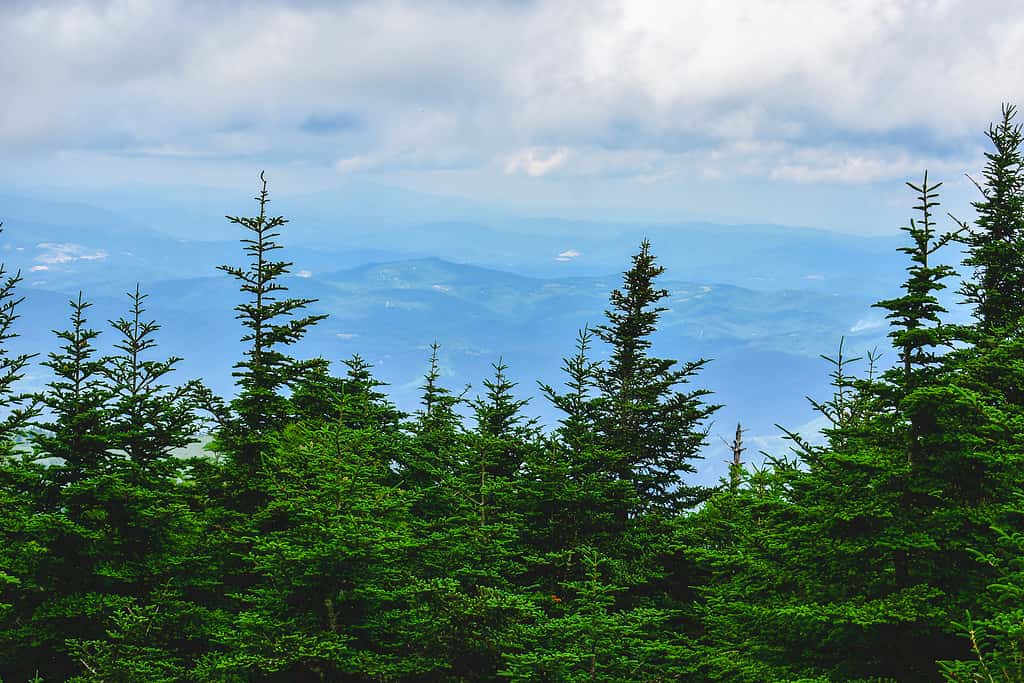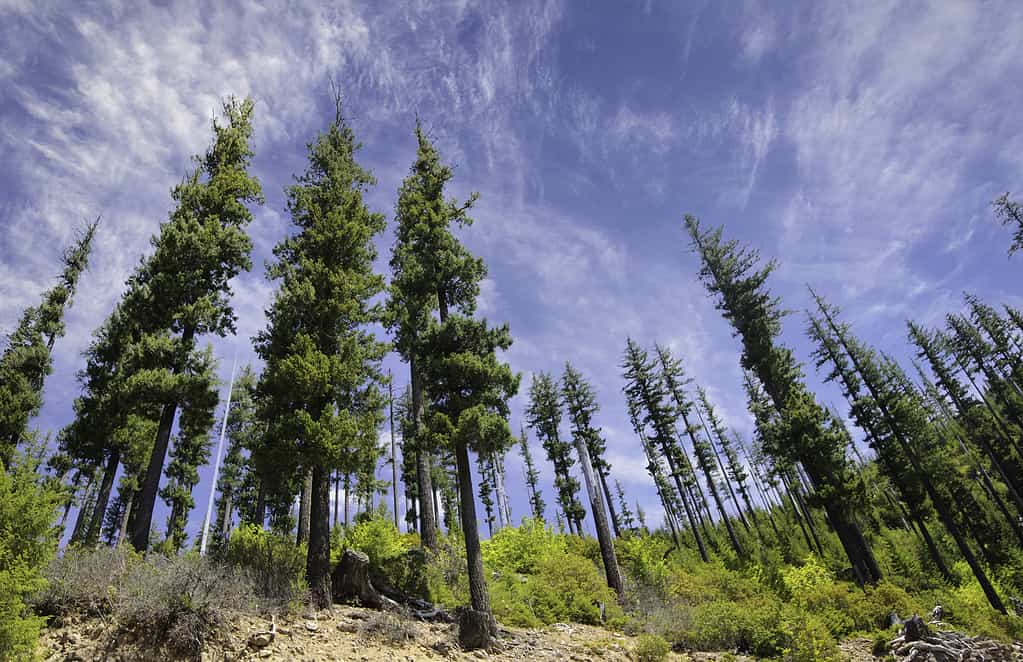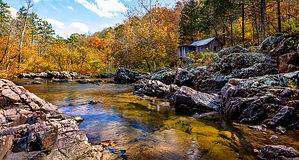Fraser firs and Douglas firs are popular Christmas trees. They are coniferous evergreen trees. When it comes to choosing the perfect Christmas tree for your home, the type you choose depends on what you’re looking for! Do you want tall and slender, or are you looking for bushy and stout? That is but one of the differences between these two traditional holiday trees. Continue reading to discover eight key differences in the match-up of Fraser fir vs. Douglas fir.
Distribution
The most prominent difference between the Fraser fir and the Douglas fir is in their distribution.
The Fraser fir (Abies fraseri) is native to the Appalachian Mountains of the Southeastern United States. They grow primarily along the North Carolina-Tennessee border. The tree’s name is an homage to the Scottish botanist John Fraser, who explored the Appalachians in the late 18th century.

Fraser firs, like these on Mt. Mitchell, North Carolina, are popular Christmas trees.
©Alex H Murrell/Shutterstock.com
The Douglas fir (Pseudotsuga menziesii) grows in the Pacific Northwest. It also grows in the higher elevations of Arizona, Colorado, New Mexico, and Utah. David Douglas, the Scottish botanist and explorer, is for whom the tree is named. These species now grow commercially in many areas of the world.

The Douglas fir grows in the Pacific Northwest. It also grows in the higher elevations of Arizona, Colorado, New Mexico, and Utah.
©Hugh K Telleria/Shutterstock.com
Fraser Fir vs. Douglas Fir: Height
Height is another principal difference between the Fraser fir and the Douglas fir. As you might imagine, the Douglas fir of the Pacific Northwest is exceptionally taller than the Fraser fir of the Appalachians. In its native range, the Douglas fir reaches heights of 250-300 (76-91 m) feet tall. In contrast, Fraser firs top out at 80 feet (24 m) maximum and are more likely to grow between 40-60 feet (12-18 m) tall. Cultivated varieties of these trees tend to be shorter.
Tall Skinny or Short and Stout?
Once you have determined its placement, you’ll know whether you’re in the market for a tall, slender tree or a shorter, wider one.
Fraser firs have a classic conical or pyramid shape, with a narrow, pointed crown. Fraser firs tend to be more slender than other fir species. They have a more compact growth habit compared to some species of Douglas fir.
Douglas firs are bushier, with the same pyramidal to a conical shape. Still, the crown can be more open and irregular compared to the more symmetrical shape of a Fraser fir.
Fraser Fir vs. Douglas Fir: Cones
The cones of these two coniferous trees are another one of their key differences.
Fraser fir cones are relatively small, 1.6-2.2 inches (4-5.5 cm). They have a cylindrical shape with a slightly tapering form. The cones of Fraser fir have a distinctive purplish tint. The scales of Fraser fir cones are soft and flexible. The trees do not begin to produce cones for many years.
Douglas fir cones are generally larger than those of Fraser fir, measuring 2 to 4 inches (5 to 10 cm) in length. They have an elongated, oblong shape with three-pointed bracts protruding from each cone scale. They often have a brown hue. The scales of Douglas fir cones are woody and can be prickly to the touch.
Needles
The needles of the Fraser fir tend to be shorter than the needles of the Douglas fir. Fraser needles are generally 0.5 to 1 inch (1.25 to 2.5 cm) long. The needles are soft to the touch, and they are relatively flexible compared to some other conifer species.
Douglas fir needles are comparatively longer at 1 -1.5 inches (2.5 to 3.8 cm). The needles are arranged spirally along the branches. They have a shiny appearance. Douglas fir needles are flat and soft to the touch. They are not prickly like some other coniferous needles.
Color
Beyond their length, the needles of the Fraser fir and the Douglas fir also differ in color.
Fraser fir needles are dark green on the upper surface with a silvery or white band on the lower surface, creating a two-toned or bicolor effect. These trees appear to have a silvery sheen. This is due to the two silvery-white rows of stomata on the bottom side of the needle. Stomata are the part of the tree responsible for photosynthesis and transpiration.
Douglas fir needles span the spectrum of green. Their needles may appear bright green to gray to blue. The stomata of Douglas fir needles are not discernable to the naked eye.
Fraser Fir vs. Douglas Fir: Scent
Both Fraser firs and Douglas firs emit pleasing, fresh, piny scents. Fraser fir needles have a soothing scent, especially when crushed or rubbed. The Fraser fir is marginally less fragrant than the Douglas fir. Douglas firs have a stronger, more earthy, though still pleasant scent. Their scents are one of the characteristics that make these trees popular in holiday decorations, from trees to wreaths and garlands.
Lifespan
The Fraser fir has a much briefer lifespan than the Douglas fir. Under optimal conditions, Fraser firs live from 50 to 80 years. However, some individual trees may live longer, especially when left undisturbed in favorable environments. Fraser firs cultivated as Christmas trees are harvested well before they reach maturity.
In their natural habitats, Douglas firs have much long lifespans. Some individual trees live for several centuries, with lifespans ranging from 500 to over 1,000 years! Though they are cultivated as Christmas trees, Douglas firs are principally used as lumber. These trees, grown in managed forests, are harvested between 40 and 60 years old.
Thank you for reading! Have some feedback for us? Contact the AZ Animals editorial team.








